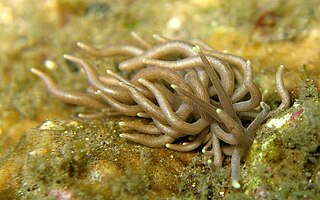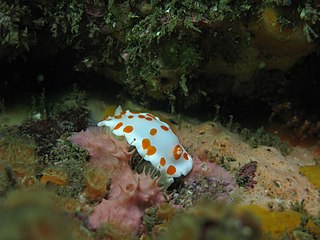
The Chromodorididae, or chromodorids, are a taxonomic family of colourful, sea slugs; dorid nudibranchs, marine gastropod mollusks in the superfamily Doridoidea. “Chromodorid nudibranchs are among the most gorgeously coloured of all animals.” The over 360 described species are primarily found in tropical and subtropical waters, as members of coral reef communities, specifically associated with their sponge prey. The chromodorids are the most speciose family of opisthobranchs. They range in size from <10mm to over 30 cm, although most species are approximately 15–30 mm in size.

Chromodoris annae is a species of sea slug, a very colourful nudibranch, a shell-less marine gastropod mollusc in the family Chromodorididae.

Nembrotha lineolata is a species of nudibranch, a sea slug, a marine gastropod mollusk in the family Polyceridae. It is found in shallow water in the Indo-Pacific. It was first described in 1905 by the Danish malacologist Rudolph Bergh. The type locality is Selayar Island, Indonesia.

Phyllodesmium briareum is a species of sea slug, an aeolid nudibranch, a marine gastropod mollusc in the family Facelinidae.

Nembrotha cristata is a species of colourful sea slug, a polycerid nudibranch, a marine gastropod mollusk in the family Polyceridae. This species of sea slug is black with green markings; adults are around 50 mm in length, and they live on rock or coral reefs in the tropical Indo-West Pacific Ocean.

The frilled nudibranch, Leminda millecra, is a species of metarminid nudibranch, and is only found in South Africa. It is a marine gastropod mollusc in the family Charcotiidae.

Phyllodesmium is a genus of predatory sea slugs, aeolid nudibranchs, marine gastropod molluscs in the family Facelinidae.

Phyllodesmium longicirrum, common name the solar-powered phyllodesmium, is a species of sea slug, an aeolid nudibranch, a marine gastropod mollusc in the family Facelinidae.

Phyllodesmium crypticum is a species of sea slug, an aeolid nudibranch, a marine gastropod mollusc in the family Facelinidae.

Goniobranchus tasmaniensis is a species of colourful sea slug, a dorid nudibranch, a marine gastropod mollusc in the family Chromodorididae.

Mexichromis pusilla is a species of sea slug or dorid nudibranch, a marine gastropod mollusk in the family Chromodorididae.

Phestilla is a genus of sea slugs, aeolid nudibranchs, marine gastropod molluscs in the family Trinchesiidae. Its members are unusual in feeding on hard corals, unlike other members of the family Trinchesiidae which feed on hydroids. Adult Phestilla have no cnidosacs. This genus has been investigated using DNA phylogeny and undescribed species exist.

Rostanga bifurcata is a species of sea slug, a dorid nudibranch, a marine gastropod mollusc in the family Discodorididae.
Rostanga crawfordi is a species of sea slug, a dorid nudibranch, a marine gastropod mollusc in the family Discodorididae. Originally described as Discodoris crawfordi, it was redescribed by Rudman & Avern as Rostanga australis. The two names were synonymised by Dayrat.

Phestilla lugubris is a species of sea slug, an aeolid nudibranch, a marine gastropod mollusk in the family Trinchesiidae.
Phestilla sibogae is a species of sea slug, an aeolid nudibranch, a marine gastropod mollusk in the family Trinchesiidae. The species feeds on the hard coral genus Porites.

Phestilla minor is a species of sea slug, an aeolid nudibranch, a marine gastropod mollusk in the family Trinchesiidae. The species feeds on the hard coral genus Porites and has been found to represent a species complex.
Phestilla panamica is a species of sea slug, an aeolid nudibranch, a marine gastropod mollusk in the family Trinchesiidae. The species feeds on the hard coral genus Porites.
Phestilla poritophages is a species of sea slug, an aeolid nudibranch, a marine gastropod mollusk in the family Trinchesiidae. The species was named after its prey genus, the hard coral Porites.














